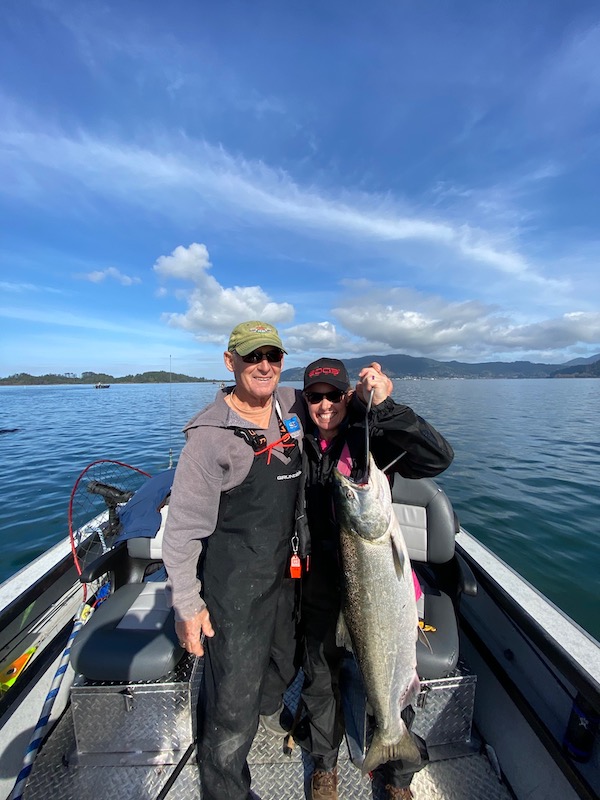
It’s Door 2 – Oregon Coast Fall Chinook Seasons Announced
THE FOLLOWING IS A PRESS RELEASE FROM THE OREGON DEPARTMENT OF FISH AND WILDLIFE
After evaluating survey feedback and other comments, ODFW today announced fishing regulations for 2023 fall Chinook and coho fisheries in rivers along Oregon’s coast (from the Necanicum River to the Winchuck River).

For the full list of Chinook regulations that take effect as early as July 1 in some rivers, visit the Fishing Report for the SW Zone and NW Zone and click Regulation Updates. Proposed coho regulations are available on the fall coastal salmon webpage; they are considered tentative until final approval from the National Marine Fisheries Service (which is required because Oregon coast coho are listed under the federal Endangered Species Act).
Relative to last year, ODFW is expecting a better fall salmon season on the coast this year. Another strong return of coho is expected, allowing the opening of additional rivers to wild harvest. Likewise, the outlook for wild fall Chinook fisheries is improved, though bag limits are conservative due to ongoing concerns for Chinook.
“Last year we had a lot of closures because of the impact of ongoing drought and poor ocean conditions. This year, the returns to many basins are expected to be better so rivers like the Tillamook, Siuslaw, and Floras that were closed last year will be open,” said Shaun Clements, ODFW Deputy Fish Division Administrator. “Similarly, last year there was very limited opportunity in the Coos basin because of a low expected return, but this year’s outlook is much better and bag limits are increased substantially in that basin.”
Fisheries for wild Chinook will take place in 19 of 21 coastal systems (only the Elk and Coquille are closed in 2023), an improvement over 2022 when five rivers were closed.
Earlier this month, ODFW fish biologists hosted a webinar to discuss potential regulations and the outlook for wild Chinook and wild coho runs to rivers along Oregon’s coast. After the webinar, they asked anglers and others interested to fill out a survey to provide feedback.
The survey specifically asked for feedback about two different bag limits (Alternatives 1 and 2) for fall Chinook in certain rivers. Alternative 1 would have taken a consistent coastwide approach to setting reduced bag limits for each basin, in recognition of concerns about the factors impacting Chinook. Alternative 2 would allow additional harvest in several rivers based on a range of factors, including the forecast and recent trends.
Over 700 people responded to the survey. Survey feedback was nearly evenly split between Alternatives 1 and 2 (49/51 percent respectively), though more respondents (56 percent) who primarily fish in Mid Coast rivers preferred Alternative 2. This area of the coast had more flexibility between the alternatives.
Based on the feedback from anglers and groups, ODFW selected Alternative 2, which still provides needed protections in the basins of highest concern (including Tillamook, Nestucca, Siuslaw, Umpqua and Floras/New). In the remaining basins, regulations take a middle ground approach, allowing additional opportunity on runs that do not have the same level of concern currently but providing additional protection against error in the forecasts that have caused issues recently.
“ODFW is paying close attention to these runs. We know these fisheries are important to coastal communities and we want to ensure anglers can continue to harvest fish over the long run,” said Clements. “We have demonstrated over many decades that harvest can be sustainable if it is scaled based on health of runs to ensure enough fish make it to spawning to produce the next generation.”
“Unfortunately, we’re seeing warning signs regionwide, with many fisheries closing from California to Alaska,” continued Clements. “We’re also seeing concerning signs in several basins that have been at or below critical abundance for several years, increasing freshwater harvest rates, and more uncertainty in the forecasts because of the changing climate and ocean conditions.”
“We want to do everything we can to avoid closures, but that means paying attention to the data and responding to the changes,” added Clements. “The adjustments we’re making this year will help runs keep pace with the changes they are experiencing elsewhere in their lifecycle and help keep fisheries open.”.
Chinook regulations for ocean areas adjacent to the Nehalem and Tillamook rivers and a decision on ocean terminal area fisheries for the Elk/Sixes and Chetco will be announced later this year.
For coho, with the third consecutive year of good returns expected, more rivers should be open for wild coho harvest than last year (Siuslaw, Coquille and Floras/New added; Umpqua would be closed due to exceptionally low returns to South Umpqua in 2022). Again, coho regulations are considered tentative until final approval from the National Marine Fisheries Service, which is required because Oregon coast coho are listed under the federal Endangered Species Act.
Note these regulations are only for adult wild Chinook and wild coho. Hatchery fish and jacks can be retained per permanent regulations (except in the Coquille River which is closed to all Chinook fishing).
CORRECTION, 5:25 p.m., June 29, 2023: ODFW issued a corrected 13th paragraph (third from bottom) late this afternoon. This post has been updated.
